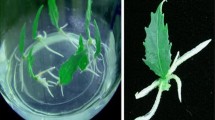Summary
Chalcone synthase in roots ofPisum sativum andPhaseolus vulgaris was demonstrated enzymatically and immunochemically. In situ localization by indirect immunofluorescence revealed that chalcone synthase is chiefly present in the lateral regions of the calyptra, in the rhizodermis, and the cortex. In the central cylinder the enzyme protein is no longer detectable a short distance behind the meristem. Chalcone synthase was not found in root tips ofZea mays. Two isoforms of chalcone synthase were separated by chromatofocusing of protein extracts from pea leaves. The two forms differed in their subunit molecular masses. The smaller isoform was not detected in roots.
Similar content being viewed by others
Abbreviations
- CHS:
-
chalcone synthase
- FITC:
-
fluorescein isothiocyanate
- IgG:
-
immunoglobulin G
- DTE:
-
dithioerythritol
References
Beerhues L, Wiermann R (1988) Chalcone synthases from spinach (Spinacia oleracea L.). I. Purification, peptide patterns, and immunological properties of different forms. Planta 173: 532–543
—, Robenek H, Wiermann R (1988) Chalcone synthases from spinach (Spinacia oleracea L.). II. Immunofluorescence and immunogold localization. Planta 173: 544–553
Bhuvaneswari TV, Solheim B (1985) Root hair deformation in the white clover/Rhizobium trifolii symbiosis. Physiol Plant 63: 25–34
—, Turgeon BG, Bauer WD (1980) Early events in the infection of soybean (Glycine max L. Merr) byRhizobium japonicum. I. Localization of infectible root cells. Plant Physiol 66: 1027–1031
Bradford MM (1976) A rapid and sensitive method for the quantitation of microgram quantities of protein utilizing the principle of protein-dye binding. Anal Biochem 72: 248–254
d'Arcy-Lameta A (1986) Study of soyabean and lentil root exudates. II. Identification of some polyphenolic compounds, relation with plantlet physiology. Plant Soil 92: 113–123
Djordjevic MA, Redmond JW, Batley M, Rolfe BG (1987) Clovers secrete specific phenolic compounds which either stimulate or repress nod gene expression inRhizobium trifolii. EMBO J 6: 1173–1179
Dudley ME, Jacobs TW, Long SR (1987) Microscopic studies of cell divisions induced in alfalfa roots byRhizobium meliloti. Planta 171: 289–301
Firmin JL, Wilson KE, Rossen L, Johnston AWB (1986) Flavonoid activation of nodulation genes inRhizobium reversed by other compounds present in plants. Nature 324: 90–92
Gleitz J, Seitz U (1989) Induction of chalcone synthase in cell suspension cultures of carrot (Daucus carota L. sp.sativus) by ultraviolet light: evidence for two different forms of chalcone synthase. Planta 179: 323–330
Hahlbrock K (1981) Flavonoids. In: Stumpf PK, Conn EE (eds) Biochemistry of plants, vol 7. Academic Press, New York, pp 425–456
Harborne JB, (1986) Nature, distribution and function of plant flavonoids. In: Cody V, Meddleton E Jr, Harborne JB (eds) Plant flavonoids in biology and medicine. AR Liss, New York, pp 15–24 (Progress in clinical and biological research, vol 213)
Harker CL, Ellis THN, Coen ES (1990) Identification and genetic regulation of the chalcone synthase multigene family in pea. Plant Cell 2: 185–194
Hoagland DR, Arnon DI (1938) The water-culture method for growing plants without soil. University of California Agricultural Experiment Station Circular 347, 39
Hrazdina G, Kreuzaler F, Hahlbrock K, Grisebach H (1976) Substrate specificity of flavanone synthase from cell suspension cultures of parsley and structure of release products in vitro. Arch Biochem Biophys 175: 392–399
—, Lifson E, Weeden NF (1986) Isolation and characterization of buckwheat (Fagopyrum esculentum M.) chalcone synthase and its polyclonal antibodies. Arch Biochem Biophys 247: 414–419
Köster J, Strack D, Barz W (1983) High performance liquid chromatographic separation of isoflavones and structural elucidation of isoflavone 7-0-glucoside 6″-malonates fromCicer arietinum. Planta Medica 48: 131–135
Kosslak RM, Bookland R, Barkei J, Paaren HE, Appelbaum ER (1987) Induction ofBradyrhizobium japonicum common nod genes by isoflavones isolated fromGlycine max. Proc Natl Acad Sci USA 84: 7428–7432
Kreuzaler F, Ragg H, Heller W, Tesch R, Witt I, Hammer D, Hahlbrock K (1979) Flavanone synthase fromPetroselinum hortense. Molecular weight, subunit composition, size of messenger RNA, and absence of pantetheinyl residue. Eur J Biochem 99: 89–96
Lembach A, Beerhues L, Wiermann R (1989) In situ localization of chalcone synthase inLarix needles by indirect immunofluorescence. Protoplasma 153: 58–61
Long SR (1989)Rhizobium-legume nodulation: life together in the underground. Cell 56: 203–214
Maxwell CA, Phillips DA (1990) Concurrent synthesis and release of nod-gene-inducing flavonoids from alfalfa roots. Plant Physiol 93: 1552–1558
—, Hartwig UA, Joseph CM, Phillips DA (1989) A chalcone and two related flavonoids released from alfalfa roots induce nod genes ofRhizobium meliloti. Plant Physiol 91: 842–847
Ozeki Y, Sakano K, Komamine A, Tanaka Y, Noguchi H, Sankawa U, Suzuki T (1985) Purification and some properties of chalcone synthase from a carrot suspension culture induced for anthocyanin synthesis and preparation of its specific antiserum. J Biochem 98: 9–17
Peters NK, Long SR (1988) Alfalfa root exudates and compounds which promote or inhibit induction ofRhizobium meliloti nodulation genes. Plant Physiol 88: 396–400
—, Frost JW, Long SR (1986) A plant flavone, luteolin, induces expression ofRhizobium meliloti nodulation genes. Science 233: 977–980
Rao AS (1990) Root flavonoids. Bot Rev 56: 1–84
Read SM, Northcote DH (1981) Minimization of variation in the response to different proteins of the Coomassie Blue G dye-binding assay for protein. Anal Biochem 116: 53–64
Redmond JW, Batley M, Djordjevic MA, Innes RW, Kuempel PL, Rolfe BG (1986) Flavones induce expression of nodulation genes inRhizobium. Nature 323: 632–635
Schmid J, Doerner PW, Clouse SD, Dixon RA, Lamb CJ (1990) Developmental and environmental regulation of a bean chalcone synthase promoter in transgenic tobacco. Plant Cell 2: 619–631
Welle R, Grisebach H (1987) Purification and properties of chalcone synthase from cell suspension cultures of soybean. Z Naturforsch. 42c: 1200–1206
Wollenweber E, Jay M (1988) Flavones and flavonols. In: Harborne JB (ed) The flavonoids. Chapman and Hall, London, pp 233–296
Author information
Authors and Affiliations
Rights and permissions
About this article
Cite this article
Rommeswinkel, M., Karwatzki, B., Beerhues, L. et al. Immunofluorescence localization of chalcone synthase in roots ofPisum sativum L. andPhaseolus vulgaris L. and comparable immunochemical analysis of chalcone synthase from pea leaves. Protoplasma 166, 115–121 (1992). https://doi.org/10.1007/BF01322775
Received:
Accepted:
Issue Date:
DOI: https://doi.org/10.1007/BF01322775




